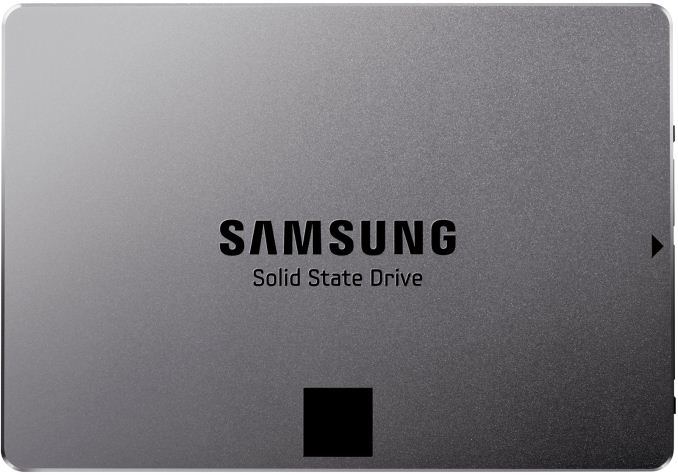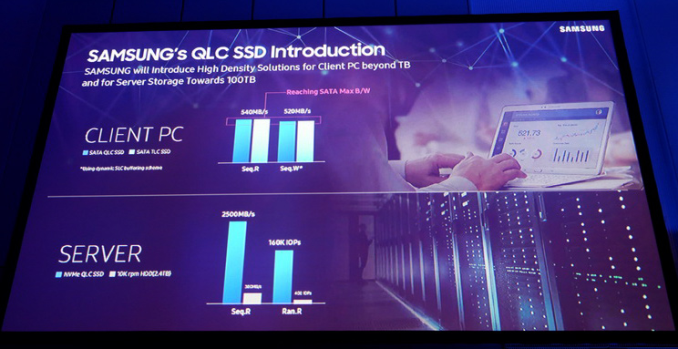Samsung Discloses First Details About QLC-Based Client & Server SSDs
by Anton Shilov on July 25, 2018 12:00 PM EST
It is not a secret that Samsung deliberately avoided QLC NAND with its 64-layer V-NAND flash, in the process citing various reasons. With its 96-layer V-NAND however, the company is changing its approach and is going to offer QLC-based SSDs for client and server computers. At the Samsung SSD Forum in Japan the company disclosed the first details about the upcoming drives.
The key advantage of 3D QLC NAND over 3D TLC is of course a 33% higher storage density and therefore a lower per-bit storage cost (assuming a similar yield). Therefore, the first drives to adopt Samsung’s 3D QLC V-NAND will be high-capacity SSDs for those customers who need to store a lot of data and may not be that interested in the maximum performance.
Samsung has been openly working on ultra-high-capacity SAS/U.2 SSDs based on QLC V-NAND memory for well over a year now. These drives will be used for WORM (write once, read many) applications not optimized for fast writes, but clearly outperforming HDD-based arrays. Samsung expects its first QLC-powered NVMe drives to offer up to 2500 MB/s sequential read speed as well as up to 160K random read IOPS, significantly outperforming high-end 10K RPM HDDs. Evidently, high-capacity QLC-based SSDs are supposed to substitute multiple 10K RPM hard drives working in a RAID array, so comparing performance of a single SSD to a 2.4 TB HDD may not be too representative, especially when power consumption is taken into account.
Another lineup of Samsung’s products to use 3D QLC V-NAND will be client SSDs featuring capacities higher than 1 TB. These drives will use a SATA interface and will offer sequential read and write performance of around 520 MB/s (when SLC write caching is enabled), according to details that Samsung disclosed at its SSD Forum. Samsung does not disclose when such drives are set to become available, but the company says that Terabyte-class client SSDs will become mainstream in 2020 because of QLC V-NAND.
In the meantime, Samsung does not expect QLC V-NAND to replace TLC V-NAND as the mainstream type of flash memory any time soon. QLC NAND requires more expensive controllers with considerably higher processing capabilities to guarantee a proper endurance. Therefore, the low-cost per-bit advantages of memory may not be that obvious on client SSDs.
Related Reading:
- Samsung Begins Mass Production Of 96L 3D NAND
- Western Digital Begins to Sample QLC BiCS4: 1.33 Tbit 96-Layer 3D NAND
- Intel Teases Upcoming QLC SSD For Datacenters
- We Found a Prototype 4 TB Intel QLC SSD
- Intel QLC NAND Updates: Up to 20TB In 2.5-inch SSD
- Intel And Micron Launch First QLC NAND: Micron 5210 ION Enterprise SATA SSD
- Toshiba's 768Gb 3D QLC NAND Flash Memory: Matching TLC at 1000 P/E Cycles?
Source: PC Watch











16 Comments
View All Comments
Arnulf - Thursday, July 26, 2018 - link
Hey Samsung, no need to tarnish (SSD) brand name with QLC trash.Leave QLC garbage to low-end and mid-range peddlers and consider spinning off a separate low-range entity if you insist on going down the QLC route.
close - Thursday, July 26, 2018 - link
Everybody will go down the QLC route. Just like they went from SLC to MLC to TLC. It's cost effective, it will have a real-life reliability close enough to everything else on the market now, and it's the most accessible way of fulfilling the ever increasing need for capacity.So whether you want to or not you'll be using "trash" in the near future.
Amandtec - Thursday, July 26, 2018 - link
Samsung puts a SLC cache on their EVO drives, so unless you do unusual things with your computer the vast majority of all activity is happening there. You can also use Optane if you are super hardcore.Alexvrb - Thursday, July 26, 2018 - link
For most consumers a halfway decent QLC design will be more than adequate for the life of their device, and it's a CRAPLOAD better and more reliable than a consumer-grade spinner. So if they can get densities up and prices down, I'm all for 96+ layer QLC for mainstream consumer systems - especially entry-level laptops!With that being said if you're an enthusiast and you're trying to go all-solid-state, QLC still has a purpose: Secondary storage. You use a fast MLC (or next-gen storage) PCIe-based NVMe drive (even M.2 x4 PCIe is good enough for all but the most elite systems) for the main storage. Then you can get a large QLC drive for storing video/music/etc. Data that doesn't get constantly manipulated won't wear the drive out, and it will be far more robust against random premature failures than consumer (or even many enterprise) spinners.
Alexvrb - Thursday, July 26, 2018 - link
Fast *TLC. Sorry. TLC is plenty good, even though everyone wanted to go full Chicken Little when it started taking over.PeachNCream - Thursday, July 26, 2018 - link
Yay for 500 P/E cycles! That bar for endurance keeps getting lower. No doubt we'll be telling each other that QLC will be good enough for our needs just like we did for TLC NAND. There's no clear replacement for NAND flash out there as there's an absence of new, more durable storage technologies that have any momentum behind them. I had hopes for Optane, but it seems like its going to end up acting as slow RAM rather than durable solid state storage.Reflex - Thursday, July 26, 2018 - link
Optane is still ramping up, to early to tell where it's going. That said, despite ever lower numbers of cycles SSD reliability is very high. I'm honestly not worried about QLC, although my initial use will be in my NAS to finally replace spinning disks (assuming it can become cost competitive). When most operations are reads rather than rights the cycle total does not matter.Amandtec - Thursday, July 26, 2018 - link
After several years with my SSD I think I am at 5. Yup, that two orders of magnitude still to go.The trick with Optane is to use it with Fuzedrive - 2GB DDR4, 32 GB Optane, 500 GB SSD, 4TB HDD - each order of magnitude in storage size is slower but cheaper. No need to store your 1Tb of cosplay photos on an Optane drive.
PeachNCream - Friday, July 27, 2018 - link
Nonsense, I want my cosplay pics on fast Optane storage because they NEED to be accessible as quickly as possible as my whims dictate!In all seriousness, the tiered storage you're proposing is rather complicated and PCB/space/power intensive. I'd rather limit the number of levels in the storage pyramid to something like RAM, Internal Persistent Storage, External Backup. Your proposed path is realistic and perfectly reasonable for a desktop PC in a home managed by someone with a baseline understanding of technology. In my case, I don't own a desktop and I go days (sometimes a week or two) without even turning on my laptop. Systems like the Stream 11 Pro from HP are what I'd like to see in computers going forward due to their price, passive cooling, and simplicity. When my Latitude e6430 suffers from some sort of major failure, something like that is the likely future of x86/Windows computing for me. Adding layers of storage complexity makes that prospect difficult when you're dealing with such limits.
FullmetalTitan - Thursday, July 26, 2018 - link
Have you ever even seen the EOL of an SSD by consumption of flash cell endurance? I have been using a shitty OCZ drive with a sandforce controller as a boot drive and primary app partition for like 6 years now and endurance metrics before last system build showed it at 92% drive lifetime still. I guarantee your drives will fail for one of 20 other reasons before you come close to flash endurance limits.